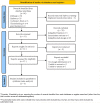Clinical Utility of Circulating Pentraxin 3 as a Prognostic Biomarker in Coronavirus Disease 2019: A Systematic Review and Meta-analysis
- PMID: 36443545
- PMCID: PMC9707160
- DOI: 10.1007/s40121-022-00730-9
Clinical Utility of Circulating Pentraxin 3 as a Prognostic Biomarker in Coronavirus Disease 2019: A Systematic Review and Meta-analysis
Abstract
Introduction: Pentraxin 3 (PTX3) is involved in inflammation regulation and has a certain association with infectious diseases. However, its specific correlation with infectious diseases remains controversial. This study aimed to analyze the association between them and explore the possible role of PTX3 in the prognosis of coronavirus disease 2019 (COVID-19).
Methods: Five databases (PubMed, Cochrane Library, Embase, Clinicaltrials.gov, and gray literature) were searched. Outcomes were expressed as a standardized mean difference (SMD) and 95% confidence intervals (CI). The Newcastle-Ottawa Scale (NOS) was used to evaluate the quality of included articles. Stata 12 and Meta-DiSc were applied to analyze the pooled data. Receiver operating characteristic (ROC) curves were conducted to determine the prognostic value of PTX3 for mortality.
Results: Six articles met the inclusion criteria. Circulating PTX3 levels had a nonsignificant difference between intensive care unit (ICU) and non-ICU patients with COVID-19 [SMD 1.37 (-0.08, 2.81); I2 = 93.9%, P < 0.01], while the PTX3 levels in nonsurvival COVID-19 patients was significantly lower than those in survival patients [SMD -1.41 (-1.92, -0.91); I2 = 66.4%, P = 0.051]. Circulating PTX3 had good mortality prediction ability (area under ROC curve, AUC = 0.829) in COVID-19. Funnel plots and Egger's tests showed low probabilities of publication bias. Through sensitivity analysis, the results of this study were robust.
Conclusion: This study found that PTX3 was differentially expressed between survival and nonsurvival patients with COVID-19, while there was no significant difference between ICU and non-ICU patients. Meanwhile, circulating PTX3 may be a good biomarker for monitoring the prognosis of COVID-19, which may provide new ideas and directions for clinical and scientific research.
Keywords: COVID-19; Coronavirus disease; Meta-analysis; PTX3; Pentraxin 3.
Plain language summary
This study focuses on the relationship between circulating pentraxin 3 (PTX3) and coronavirus disease 2019 (COVID-19). COVID-19 can initiate the inflammatory reaction of the body, trigger a series of immune mechanisms, and cause death in severe cases. PTX3 is a soluble pattern recognition molecule (PRM) belonging to the humoral innate immune system, which may be increasingly deemed as an independent strong prognostic indicator in severe infectious diseases, such as COVID-19. Five databases (Pubmed, Cochrane Library, EMBASE, Clinicaltrials.gov, and gray literature) were searched for six keywords. There was no significant difference in circulating PTX3 levels between intensive care unit (ICU) and non-ICU patients with COVID-19, while the PTX3 levels of nonsurvival patients with COVID-19 was significantly lower than those of survival patients. Circulating PTX3 may indicate good diagnostic value in predicting the mortality of COVID-19, which may be useful as an indicator for monitoring.
© 2022. The Author(s).
Figures






Similar articles
-
Increased Circulating Pentraxin 3 Levels in Patients with Rheumatoid Arthritis: A Meta-analysis.Curr Pharm Des. 2022;28(27):2260-2269. doi: 10.2174/1381612828666220614155037. Curr Pharm Des. 2022. PMID: 35708089
-
Pentraxin 3 is more accurate than C-reactive protein for Takayasu arteritis activity assessment: A systematic review and meta-analysis.PLoS One. 2021 Feb 2;16(2):e0245612. doi: 10.1371/journal.pone.0245612. eCollection 2021. PLoS One. 2021. PMID: 33529185 Free PMC article.
-
Pentraxin-3 (PTX-3) as a potential biomarker for predicting death in hospitalized patients with COVID-19.Virol J. 2024 Sep 27;21(1):233. doi: 10.1186/s12985-024-02501-z. Virol J. 2024. PMID: 39334467 Free PMC article.
-
Long pentraxin 3 as a marker of COVID-19 severity: evidences and perspectives.Biochem Med (Zagreb). 2022 Jun 15;32(2):020901. doi: 10.11613/BM.2022.020901. Epub 2022 Apr 15. Biochem Med (Zagreb). 2022. PMID: 35464745 Free PMC article.
-
Prognostic Value of Pentraxin3 Protein Expression in Human Malignancies: A Systematic Review and Meta-Analysis.Cancers (Basel). 2024 Nov 7;16(22):3754. doi: 10.3390/cancers16223754. Cancers (Basel). 2024. PMID: 39594709 Free PMC article. Review.
Cited by
-
Time- and temperature-dependent Pentraxin 3 stability in serum and bronchoalveolar lavage fluid samples.Med Mycol. 2025 Jul 2;63(7):myaf057. doi: 10.1093/mmy/myaf057. Med Mycol. 2025. PMID: 40576635 Free PMC article.
-
Searching for New Biomarkers to Assess COVID-19 Patients: A Pilot Study.Metabolites. 2023 Dec 10;13(12):1194. doi: 10.3390/metabo13121194. Metabolites. 2023. PMID: 38132876 Free PMC article.
-
The Prognostic Value of Pentraxin-3 in COVID-19 Patients: A Systematic Review and Meta-Analysis of Mortality Incidence.Int J Mol Sci. 2023 Feb 10;24(4):3537. doi: 10.3390/ijms24043537. Int J Mol Sci. 2023. PMID: 36834949 Free PMC article.
-
Optical Bionanosensors for Sepsis Diagnostics.Small. 2025 Feb;21(8):e2409042. doi: 10.1002/smll.202409042. Epub 2025 Jan 2. Small. 2025. PMID: 39745136 Free PMC article. Review.
References
Publication types
Grants and funding
LinkOut - more resources
Full Text Sources
Miscellaneous

